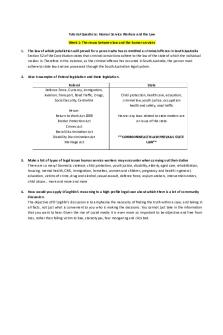Statistics Tutorial 8 Questions PDF

| Title | Statistics Tutorial 8 Questions |
|---|---|
| Course | Economics 2 |
| Institution | The University of Edinburgh |
| Pages | 5 |
| File Size | 1.2 MB |
| File Type | |
| Total Downloads | 26 |
| Total Views | 138 |
Summary
Statistics Tutorial 8 Week 9 Questions Semester 1...
Description
Economics 2 — Statistics — Semester 1 — Tutorial Sheet 8 — Week 9
Inference Data
for
Categorical
Required reading: -
Recent lecture notes Diez, Barr, &Çetinkaya-Rundel, Introductory Statistics with Randomization and Simulation o Chapter 3, section 3.1
Additional resources: - The Khan Academy (www.khanacademy.org)
is a fantastic resource for students who are struggling with the material used in this course. See:
https://www.khanacademy.org/math/probability
Tutorial Questions Refer to the Normal Probability Table at the End of This Sheet Q1: Gender. Let X represent the gender of the next person you meet, where X = 0 indicates that the person is female and X = 1 indicates that he is male. The probability that X = 1 is p. (a) Calculate the expected value of X. (b) Calculate the variance and standard deviation of X. (c) Suppose you meet 10 people at random. Let ^p represent the proportion of these 10 people that are male. What is the standard error of ^ p ? Q2. Orange tabbies. Suppose that 90% or orange tabby cats are male. You don’t know this so you randomly sample n tabby cats from the population. Determine if the following statements are true or false, and explain your reasoning. (a) The distribution of sample proportions of random samples of size 30 is left skewed. (b) The expected value of your sample proportion your sample size n.
^p
is increasing in
(c) Suppose you receive a large amount of research funding and are able to sample half of all tabby cats in the population. So long as your sample is random, you can be confident that your observations are independent.
Q3. Legalisation of Marijuana. The 2010 General Social Survey asked 1,259 respondents: “Do you think the use of marijuana should be made legal, or not?” 48% of the respondents said it should be made legal.1 (a) Is 48% a sample statistic or a population parameter? Explain. (b) Construct a 95% confidence interval for the proportion of US residents who think that marijuana should be made legal, and interpret it in the context of the data. What does a 95% confidence level imply in this context? (c) A critic points out that this 95% confidence interval is only accurate if the statistic follows a normal distribution, or if the normal model is a good approximation. Is this true for these data? Explain. (d) A news piece on this survey’s findings states, “We can safely say that a majority of Americans think marijuana should be legalised.” Based on your confidence interval, is this news piece’s statement justified? 1 National Opinion Research Center, General Social Survey, 2010.
(e) If we wanted to limit the margin of error of a 95% confidence interval to 2 percentage points, about how many Americans would we need to survey?
Q4. College smokers. We are interested in estimating the proportion of students at a university who smoke. Out of a random sample of 200 students from this university, 40 students smoke. Calculate a 75% confidence interval for the proportion of students at this university who smoke.
Q5. The Civil War. A national survey conducted in 2011 among a simple random sample of 1,507 adults shows that 56% of Americans think the Civil War is still relevant in American politics and political life.2 (a) Conduct a hypothesis test to determine if these data provide strong evidence that the majority of the Americans think the Civil War is still relevant. (b) Interpret the p-value in this context.
2 Pew Research Center Publications, Civil War at 150: Still Relevant, Still Divisive, data collected between March 30 – April 3, 2011.
Normal Probability Tables...
Similar Free PDFs

Statistics Tutorial 8 Questions
- 5 Pages

WEEK 8 Tutorial - questions
- 2 Pages

Statistics Tutorial 4 Solutions
- 7 Pages

BFW2401-Tutorial 8 - Tutorial
- 2 Pages

Tutorial Questions
- 15 Pages

Tutorial 8 - Bail
- 10 Pages

Tutorial Solution 8
- 9 Pages

Tutorial 8 - Binomial Trees
- 4 Pages
Popular Institutions
- Tinajero National High School - Annex
- Politeknik Caltex Riau
- Yokohama City University
- SGT University
- University of Al-Qadisiyah
- Divine Word College of Vigan
- Techniek College Rotterdam
- Universidade de Santiago
- Universiti Teknologi MARA Cawangan Johor Kampus Pasir Gudang
- Poltekkes Kemenkes Yogyakarta
- Baguio City National High School
- Colegio san marcos
- preparatoria uno
- Centro de Bachillerato Tecnológico Industrial y de Servicios No. 107
- Dalian Maritime University
- Quang Trung Secondary School
- Colegio Tecnológico en Informática
- Corporación Regional de Educación Superior
- Grupo CEDVA
- Dar Al Uloom University
- Centro de Estudios Preuniversitarios de la Universidad Nacional de Ingeniería
- 上智大学
- Aakash International School, Nuna Majara
- San Felipe Neri Catholic School
- Kang Chiao International School - New Taipei City
- Misamis Occidental National High School
- Institución Educativa Escuela Normal Juan Ladrilleros
- Kolehiyo ng Pantukan
- Batanes State College
- Instituto Continental
- Sekolah Menengah Kejuruan Kesehatan Kaltara (Tarakan)
- Colegio de La Inmaculada Concepcion - Cebu







